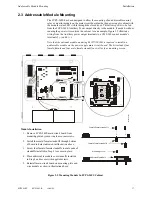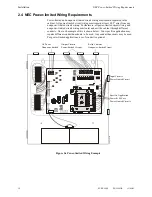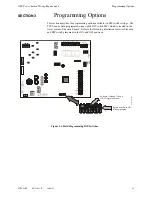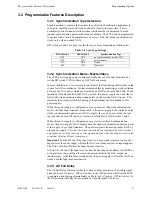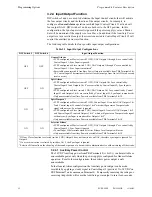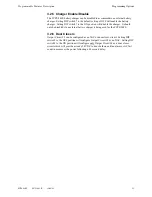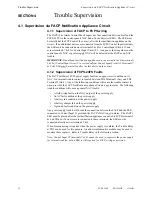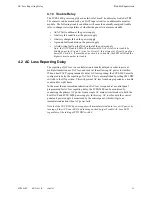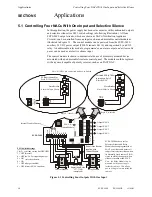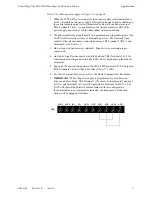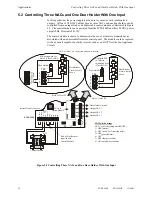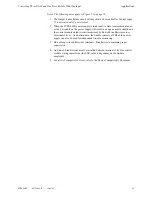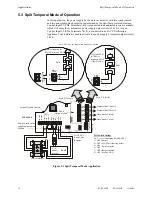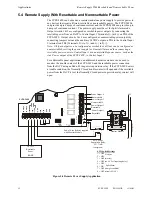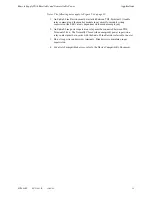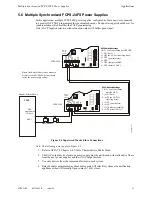
Programming Options
DIP Switch Settings
20
FCPS-24FS PN 51883:B 12/04/02
3.1 DIP Switch Settings
The following table lists the FCPS programmable features and the switch settings
required to select a particular feature. A detailed description of each feature is
presented in the following pages.
Table 3.1 DIP Switch Settings
SW1 DIP Switch
ON
OFF
1
This switch works in conjunction with switch 2 to determine the Strobe Synchronization Type
1
.
2
1 OFF, 2 OFF
= no sync (24V)
1 OFF, 2 ON
= System Sensor
1 ON, 2 OFF
= Gentex
1 ON, 2 ON
= Wheelock
3
FCPS configured for Slave Synchronization
FCPS configured for Master Synchronization
4
Delay AC Fail Reporting for 8 Hours
No Delay in AC Fail Reporting
5
This switch works in conjunction with switch 6 to determine Input to Output functions
6
5 OFF, 6 OFF = General Alarm
• FCPS configured as Master (switch 3 OFF), NAC Outputs 1 through 4
2
are controlled by Control
Input #1; Sync Input is ignored.
• FCPS configured as Slave (switch 3 ON), NAC Outputs 1 through 4
2
are controlled by Control
Input #1; Sync Input is monitored
3
.
• Resettable or nonresettable Auxiliary Power Output is available from TB4 Terminals 9 & 10. Control
Input #2 determines if reset will occur (must go from On to Off for a 6 second reset to occur).
• Output #4 function follows DIP switch 8 setting.
5 OFF, 6 ON = Split Alarm
• FCPS configured as Master (switch 3 OFF), NAC Outputs 1 & 2 are controlled by Control Input #1
and Outputs 3 & 4
2
are controlled by Control Input #2; Sync Input is ignored.
• FCPS configured as Slave (switch 3 ON), NAC Outputs 1 & 2 are controlled by Control Input #1
and Outputs 3 & 4
2
are controlled by Control Input #2; Sync Input is monitored
3
.
• Only nonresettable Auxiliary Power is available from TB4 Terminals 9 & 10.
• Output #4 function follows DIP switch 8 setting.
5 ON, 6 OFF = Split Temporal
• FCPS configured as Master (switch 3 OFF), Control Input #1 controls NAC Outputs 1 & 2
and Control Input #2 controls Outputs 3 & 4
2
which will generate a Temporal code signal without
sync; Sync Input is ignored.
• FCPS configured as Slave (switch 3 ON), Control Input #1 controls NAC Outputs 1 & 2 and Control
Input #2 controls Outputs 3 & 4
2
which will generate a Temporal code signal without sync; Sync
Input is monitored for Outputs 1 & 2
3
.
• Only nonresettable Auxiliary Power is available from TB4 Terminals 9 & 10.
• Output #4 function follows DIP switch 8 setting.
5 ON, 6 ON = Selective Silence
• FCPS configured as Master (switch 3 OFF), NAC Outputs 1 through 4
2
are controlled by Control
Input #1; Sync Input is ignored.
• FCPS configured as Slave (switch 3 ON), NAC Outputs 1 through 4
2
are controlled by Control
Input #1; Sync Input is monitored
3
.
• Control Input #2 determines when Selective Silence for all outputs will occur
4
• Only nonresettable Auxiliary Power is available from TB4 Terminals 9 & 10.
• Output #4 function follows DIP switch 8 setting.
7
Disable Charger
Enable Charger
8
Output Circuit #4 = Door Holder
Output Circuit #4 = NAC
1
Strobe Synchronization only works with non-coded NACs.
2
If Door Closer function is selected (switch 8 ON), Output 4 does not function as an NAC, therefore sync input is ignored for it.
3
If
no synchronization
is selected by switches 1 & 2, the Sync Input is ignored.
4
Selective Silence allows the silencing of the sounder portion of a horn/strobe combination device without turning off the strobe.












